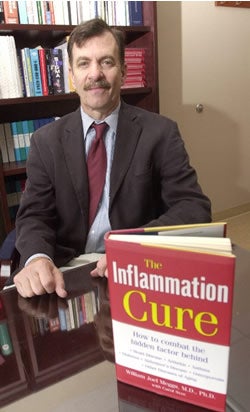ECU physician’s book calls inflammation a cause of disease
GREENVILLE, N.C. (Apr. 7, 2004) — The food we eat, the beverages we drink, the air we breathe, our pre-existing aches and pains and more all contribute to numerous diseases and maladies through one common, behind-the-scenes denominator: inflammation.
That’s the message of a new book by Dr. William Meggs, professor of emergency medicine and chief of medical toxicology at the Brody School of Medicine at East Carolina University.

Dr. William Meggs has turned his theories about the ills of inflammation and how to reverse them into a book. Photo by Cliff Hollis
The book’s full title is “The Inflammation Cure: How to Combat the Hidden Factor Behind Heart Disease, Arthritis, Asthma, Diabetes, Alzheimer’s Disease, Osteoporosis and Other Diseases of Aging” ($19.95, McGraw-Hill/Contemporary Books).
Meggs will hold a book signing April 13 at 7 p.m. at Barnes & Noble Booksellers at University Commons shopping center in Greenville.
Library Journal called the book “…readable, scientifically sound, and well-referenced … a levelheaded approach, weaving the latest research on various diseases into a broad picture.”
In “The Inflammation Cure,” Meggs and co-author Carol Svec present examples of how inflammation begins, how it affects its immediate area in the body and then how it can affect other, seemingly unrelated, areas. The authors also dispense advice on dietary, lifestyle and other changes that can reduce overall inflammation and thereby decrease the likelihood of disease and improve health.
“More and more research supports my belief that there are dietary and environmental factors that, in turn, lead to damage to the blood vessels and other parts of the boyd,” Meggs said. He cited particulates in air pollution, such as diesel exhaust, as one example of environmental factors that affect health.
“These irritating substances that people are exposed to damage tissue and lead to disease,” he said.
Meggs also said certain diseases can lead to inflammation and disease in other parts of the body. As an example, he said people with gum disease often develop coronary artery disease as well. Also, people with ulcerative colitis have a risk of colon cancer five to seven times higher than healthy people. These and other links are more than just coincidence, Meggs said.
“What we see is a connection between the condition involved and inflammation,” he said, adding that the connections aren’t yet totally understood.
Meggs has developed his theories after more than 35 years as a scientist and physician. He writes of a medical school professor who scoffed at the notion Meggs and a fellow physician had during their medical residencies that inflammation mattered. Today, research Meggs cites in his book shows the link he believed existed then.
The book is the first with Meggs as the primary author. He co-edited “Safety and Health in Agriculture, Forestry and Fishing” and has contributed chapters to other reference and textbooks. It’s also his first stab at writing for the general public. That’s where co-author Carol Svec, a health care writer based in Raleigh, came in. The pair wrote individual chapters, then combined them into a book.
“She was wonderful,” Meggs said. “I sent her my chapters and she sent me her chapters, and we would edit each other’s work. She would make my chapters more readable for the public. I think it was very good working with a professional writer whose career is writing books for the general public.”
Svec has been a freelance writer for eight years. Trained as a physiological psychologist, she has also owned a bookstore and worked for publisher Rodale. She has co-written two other books with physicians and praised Meggs’ willingness to write much of “The Inflammation Cure” himself.
“It was a joy to work with someone who has such expertise in his field and is so eager to get the information out there to the public,” Svec said.
Previously, Svec and her editor had spoken of doing a book on inflammation.